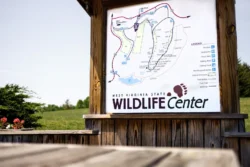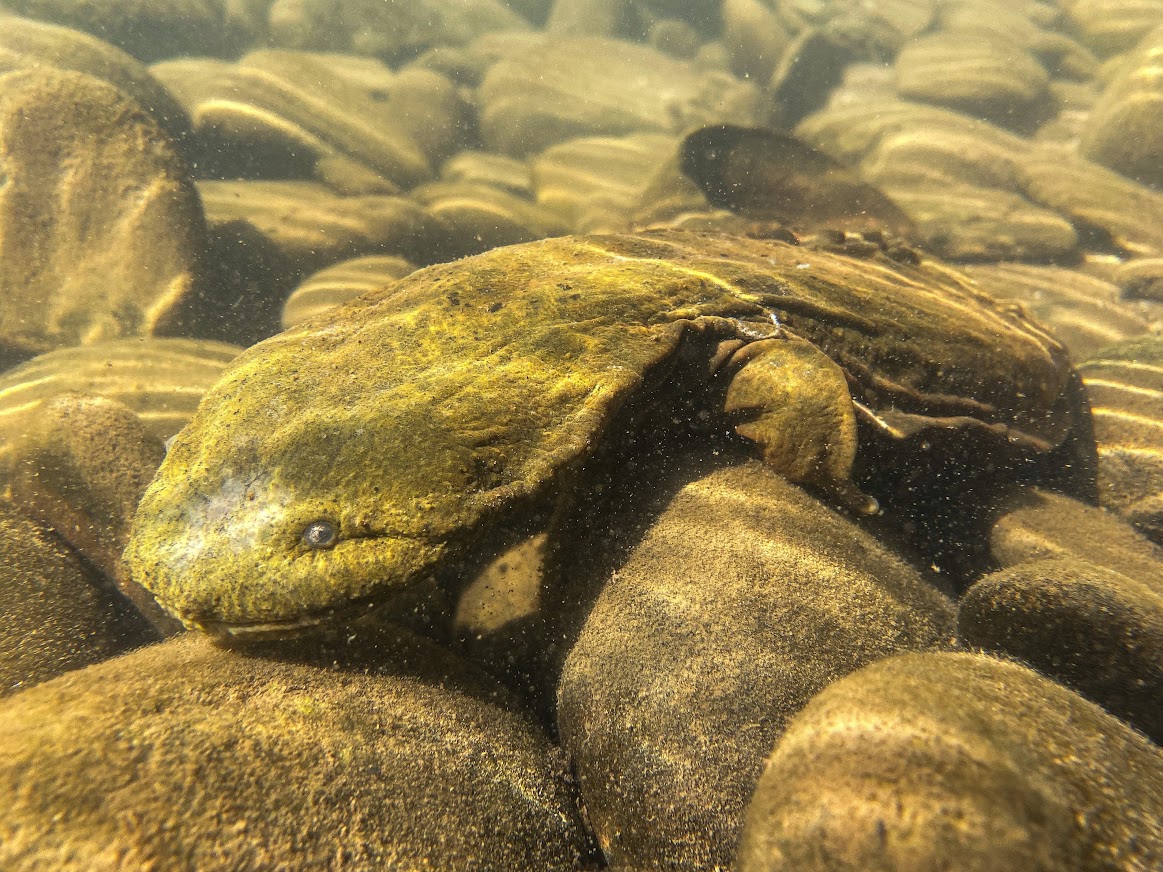Reptile and Amphibians Regulations
Effective March 23, 2021
Possession of the reptiles and amphibians, as defined by the §58CSR73 West Virginia Reptile and Amphibian Rule, is prohibited.
For complete wording of the law, see §58CSR73 West Virginia Reptile and Amphibian Rule
West Virginia’s herp regulations prohibit the possession of 80 species of reptiles and amphibians.
For a detailed explanation of the regulations regarding possession of a reptile or amphibian, view the Reptile and Amphibians Regulations Summary
West Virginia is a state rich with diverse species. It is home to 36 salamander species, 24 snake species, 15 frog and toad species, 14 turtle species, and 6 lizard species. Not only does our state have a large variety of species, it has some very rare and endemic herpetofauna including the Cheat Mountain salamander and the West Virginia spring salamander.
Amphibians
Frogs and Toads (Anurans)
West Virginia is home to 15 species of frogs and toads. Frogs and toads are amphibians in the order Anura. These animals are ectothermic vertebrates with unique skin that must remain moist, and generally have longer hind limbs, webbed toes without claws, and no tails in their adult form. Although there is no true taxonomical distinction between toads and frogs, frogs usually have smooth skin, and toads usually have warty skin and spend more time on land. The 3 toad species in West Virginia include the Eastern spadefoot, Eastern American toad, and Fowler’s toad.
All frogs and toads in West Virginia lay eggs in water, which develop into aquatic larvae with gills, go through metamorphosis, and eventually become adults with lungs and the ability to spend extended periods of time on land.
Species Accounts
Blanchard’s Cricket Frog (Acris blanchardi)
Eastern Cricket Frog (Acris crepitans)
Eastern American Toad (Anaxyrus a. americanus)
Fowler’s Toad (Anaxyrus fowleri)
Cope’s Gray Treefrog (Hyla chrysoscelis)
Gray Treefrog (Hyla versicolor)
Mountain Chorus Frog (Pseudacris brachyphona)
Spring Peeper (Pseudacris crucifer)
Upland Chorus Frog (Pseudacris ferriarum)
American Bullfrog (Lithobates catesbianus)
Green Frog (Lithobates clamitans)
Pickerel Frog (Lithobates paulustris)
Northern Leopard Frog (Lithobates pipiens)
Wood Frog (Lithobates sylvaticus)
Eastern Spadefoot (Scaphiopus holbrookii)
Salamanders
West Virginia is home to 34 species of salamanders. Salamanders are amphibians in the order Caudata. These animals are ectothermic vertebrates with unique skin that must remain moist, and are long-bodied, low to the ground, lack claws, have tails, and look similar to lizards without scales. Like other amphibians, these animals lay eggs. However, some species will metamorphose from a larval to adult stage in water, while others will hatch on land as immature versions of adults.
There are two endemic species to the state – the Cheat Mountain salamander and the West Virginia spring salamander.
Click here for more on the Salamanders of West Virginia.
Species Accounts
Streamside Salamander (Ambystoma barbouri)
Jefferson Salamander (Ambystoma jeffersonianum)
Spotted Salamander (Ambystoma maculatum)
Marbled Salamander (Ambystoma opacum)
Small-mouthed Salamander (Ambystoma texanum)
Green Salamander (Aneides aeneus)
Eastern Hellbender (Cryptobranchus a. alleghaniensis)
Northern Dusky Salamander (Desmognathus fuscus)
Seal Salamander (Desmognathus monticola)
Allegheny Mountain Dusky Salamander (Desmognathus ochrophaeus)
Black-bellied Salamander (Desmognathus quadramaculatus)
Black Mountain Salamander (Desmognathus welteri)
Northern Two-lined Salamander (Eurycea bisliniata)
Southern Two-lined Salamander (Eurycea cirrigera)
Eastern Long-tailed Salamander (Eurycea l. longicauda)
Cave Salamander (Eurycea lucifuga)
Kentucky Spring Salamander (Gyrinophilus porphyriticus duryi)
Northern Spring Salamander (Gyrinophilus p. porphyriticus)
West Virginia Spring Salamander (Gyrinophilus subterraneus)
Four-toed Salamander (Hemidactylum scutatum)
Common Mudpuppy (Necturus maculosus)
Eastern Red-backed Salamander (Plethodon cinereus)
White-spotted Slimy Salamander (Plethodon cylindraceus)
Northern Ravine Salamander (Plethodon electromorphus)
Northern Slimy Salamander (Plethodon glutinosus)
Valley and Ridge Salamander (Plethodon hoffmani)
Cumberland Plateau Salamander (Plethodon kentucki)
Cheat Mountain Salamander (Plethodon nettingi)
Yellow-spotted Woodland Salamander (Plethodon pauleyi)
Cow Knob Salamander (Plethodon punctatus)
Southern Ravine Salamander (Plethodon richmondi)
Shenandoah Mountain Salamander (Plethodon virginia)
Wehrle’s Salamander (Plethodon wehrlei)
Midland Mud Salamander (Pseudotriton montanus diasticus)
Northern Red Salamander (Pseudotriton r. ruber)
Reptiles
Lizards
West Virginia is home to 6 species of lizards. Lizards are reptiles in the order Squamata. Although there is little difference between snakes and lizards phylogenetically, we generally understand lizards to be ectothermic vertebrates with elongated bodies, limbs, closing eyelids, external ears, and scales.
All lizards in the state are small, insectivores, diurnal, and egg-laying. If you see a lizard with a blue tail, you are observing a juvenile lizard! This characteristic can be seen in several species and will fade as the lizard matures. The northern fence lizard and common five-lined skink can be found in most counties in the state, while some other species are not as common.
Species Accounts
Eastern Six-lined Racerunner (Aspidoscelis s. sexlineata)
Northern Coal Skink (Plestiodon a. anthracinus)
Common Five-lined Skink (Plestiodon fasciatus)
Broad-headed Skink (Plestiodon laticeps)
Eastern Fence Lizard (Sceloporus undulatus)
Little Brown Skink (Scincella lateralis)
Snakes
West Virginia is home to 22 species of snakes. Like lizards, snakes are reptiles in the order Squamata. Snakes are very closely related to lizards, but we recognize snakes to be scaly ectothermic vertebrates that do not have limbs, external ears, or closing eyelids. Interestingly, different species of snakes employ various reproductive strategies from live births (viviparity), to producing eggs that develop within the body and giving birth to live offspring (ovoviparity), to laying eggs (oviparity).
Two of the snake species in West Virginia are venomous, the timber rattlesnake and eastern copperhead. These two pit vipers use their venom to subdue prey, including rodents and other small mammals. Despite their reputation, they pose little danger to humans who keep their distance and do not disturb them. It is illegal to kill any snake in the wild, in West Virginia.
Species Accounts
Eastern Copperhead (Agkistrodon contortrix)
Eastern Wormsnake (Carphophis a. amoenus)
Northern Black Racer (Coluber c. constrictor)
Timber Rattlesnake (Crotalus horridus)
Northern Ring-necked Snake (Diadophis punctatus edwardsii)
Eastern Hog-nosed Snake (Heterodon platirhinos)
Eastern Kingsnake (Lampropeltis nigra)
Eastern Black Kingsnake (Lampropeltis g. niger)
Eastern Milksnake (Lampropeltis t. triangulum)
Common Watersnake (Nerodia s. sipedon)
Northern Rough Greensnake (Opheodrys a. aestivus)
Smooth Greensnake (Opheodrys vernalis)
Eastern Ratsnake (Pantherophis alleghaniensis)
Cornsnake (Pantherophis guttatus)
Gray Ratsnake (Pantherophis spiloides)
Northern Pinesnake (Pituophis m. melanoleucus)
Queen Snake (Regina septemvittata)
Dekay’s Brownsnake (Storeria dekayi)
Red-bellied Snake (Storeria occipitomaculata)
Common Ribbonsnake (Thamnophis s. saurita)
Eastern Gartersnake (Thamnophis s. sirtalis)
Mountain Earthsnake (Virginia valeriae pulchra)
Eastern Smooth Earthsnake (Virginia v. valeriae)
Turtles
West Virginia is home to 13 species of turtles, and 1 subspecies. Turtles are reptiles in the order Testudines. These ectotherms are best known for their protective shell, developed from the ribs. Some turtles, like the woodland box turtle, can close completely into their shell, protecting their limbs and head from predators. In addition to their shells, they share characteristics including scales, tails, limbs, lungs, and laying eggs on land. Some spend almost all their time underwater, others on land.
All turtles in West Virginia are aquatic or semiaquatic. Our most terrestrial turtle is the woodland box turtle. This and many other turtle species can live several decades in the wild, but there is high mortality of eggs and hatchlings. Some turtles in the state have unique shell patterns or brightly colored limbs, such as spotted turtles and wood turtles, which make them desirable for illegal collection for the pet trade. With high mortality of young, adults being illegally taken or killed on roads, and habitat change and loss, many turtle populations are in danger.




